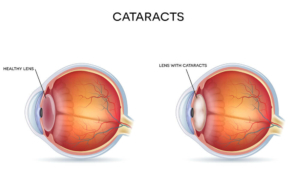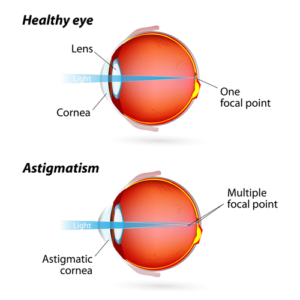What if I Don’t Want to Wear Glasses After Cataract Surgery?
Do you have cataracts? You may have realized that your vision is gradually worsening as they continue developing.
Glasses can improve your eyesight during the early stages of cataracts. But you don’t have to continue depending on glasses after cataract surgery if you don’t want to.
With the help of artificial lenses in the form of intraocular lenses implanted during cataract surgery, you can significantly reduce or even eliminate your need for glasses and contact lenses after having your cataracts removed. Keep reading to learn more about the different IOL options used during cataract surgery and which choices can reduce your dependence on glasses.
What is Cataract Surgery?

Cataracts form when proteins in your eyes build up on your natural lens, causing cloudy vision. When cataracts make simple, everyday activities difficult, your eye doctor may recommend cataract surgery.
Cataract removal is the only way to regain lost vision and see clearly. Cataract surgery is a procedure done to remove your cataracts.
During the procedure, your cataract surgeon uses ultrasonic energy to break apart your natural lens (and the cataract) into small pieces. These fragments are then gently suctioned out.
Once done, your cataract surgeon implants an artificial IOL to replace your natural lens and restore clear vision. There are different types of IOLs available. Before your cataract procedure, your surgeon will help you choose an IOL that best meets your vision needs and lifestyle.
At Eye Consultants of North Dakota, we offer the following IOLs:
Monofocal IOL

Monofocal IOLs are the most basic, standard IOL offered. They are also the only lens covered by insurance.
A monofocal IOL has one single point of focus. If you opt for clear distance vision, you’ll still need glasses for up-close and intermediate activities. You’ll be able to see well either up close, at a distance, or in between, but you can only correct for one point of focus.
A monofocal IOL delivers excellent, high-quality, far-away vision, whether night or day. Your ophthalmologist can help you decide if it’s essential to see up close, at a distance, or mid-range without glasses.
Reasons to Choose a Monofocal IOL
- Even if you have other eye conditions like dry eye, you are still a candidate
- Monofocal IOLs are covered by private insurance and Medicare
- You have other eye conditions like macular degeneration, dry eye, or glaucoma that could interfere with the technology used in premium IOLs
Although it’s less common, monovision is another option to consider when it comes to monofocal IOLs. To achieve monovision, you’ll have a lens for seeing up close put in one eye and a lens for seeing far away set in the other.
You’ll usually have your dominant eye implanted with an IOL that will allow you to see far away, and your other eye will help you see things directly in front of you. Choosing monovision can significantly decrease your dependence on prescription glasses after cataract surgery.
However, you may still need glasses when you read things with fine print, like a prescription bottle or the newspaper. It’s important to note that monovision doesn’t work for everyone.
Some people can’t adapt to using one eye for near or intermediate vision and another for distance viewing.
Multifocal IOL

Multifocal lens implants offer a full range of focus, meaning they correct vision for seeing up close, at a distance, and everything in between. With a multifocal IOL, a premium lens, you’ll be able to reduce your dependence on glasses and contact lenses.
Although multifocal IOLs give you the best chance to see at all distances without wearing glasses, they’re not perfect. Many people with these IOLs experience bothersome halos or glare that interfere with their night vision.
Because multifocal IOLs are premium lenses, insurance will not cover them. You will have to pay out-of-pocket if you choose this IOL.
Reasons to Choose a Multifocal IOL
Apart from correcting nearsightedness and farsightedness, multifocal IOLs can also address presbyopia. Presbyopia is an age-related eye condition that occurs when the natural lens loses its flexibility, usually around 40.
When this happens, focusing on things right before you become more challenging. You may experience symptoms like:
- Eye strain
- Persistent headaches
- Problems reading small print
- Trouble seeing things close-up
You can say goodbye to cataracts and the uncomfortable symptoms of presbyopia by selecting a multifocal IOL.
Toric IOLs

A toric lens implant is a type of premium IOL specially designed to fix astigmatism at the time of cataract surgery. Astigmatism happens when your cornea has an irregular shape that causes blurred or distorted vision at all distances.
Those with astigmatism may also suffer from other refractive errors like nearsightedness and farsightedness. You can attain the broadest possible range of vision with a toric IOL, considerably minimizing your reliance on eyeglasses.
However, you may still require reading glasses for near work. Like a multifocal lens, a toric IOL is an added out-of-pocket expense that insurance will not cover.
Reasons to Choose a Toric IOL
- For some cataract patients, toric lenses allow them to enjoy crisper, clearer vision than ever before
- These IOLs have incredible contrast sensitivity if you don’t have other eye conditions
Extended Depth of Focus IOLs

Extended depth of focus IOLs (EDOF) are IOLs that improve vision at a distance and at intermediate ranges. These IOLs create a single elongated focal point instead of several focal points to improve your depth of focus.
Extended depth of focus IOLs gives some flexibility with intermediate vision, which is helpful for tasks like looking at the dashboard of your car, using your smartphone, or working on the computer. EDOF lenses enhance how sharp a patient’s vision is when looking at things that are far away and an arm’s length away while clearly distinguishing color boundaries.
Extended depth of focus IOLs not only correct cataracts during surgery but also address presbyopia and help reduce dependence on glasses.
Reasons to Choose an Extended Depth of Focus IOL
- They provide sharper vision
- They improve distance vision while giving some flexibility with intermediate range vision
- They can correct presbyopia during cataract surgery
- They can reduce your dependency on visual aids
Reduce Your Dependence on Glasses with Premium IOLs
Are you looking forward to reducing your dependence on glasses after having cataract surgery? Our talented team at Eye Consultants of North Dakota can help maximize your eyesight with the best IOL for your vision and lifestyle goals after cataract surgery.
Schedule your appointment at Eye Consultants of North Dakota in Fargo, ND, today to learn more about which IOL may be right for you!



